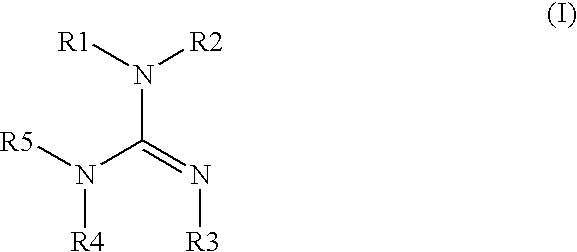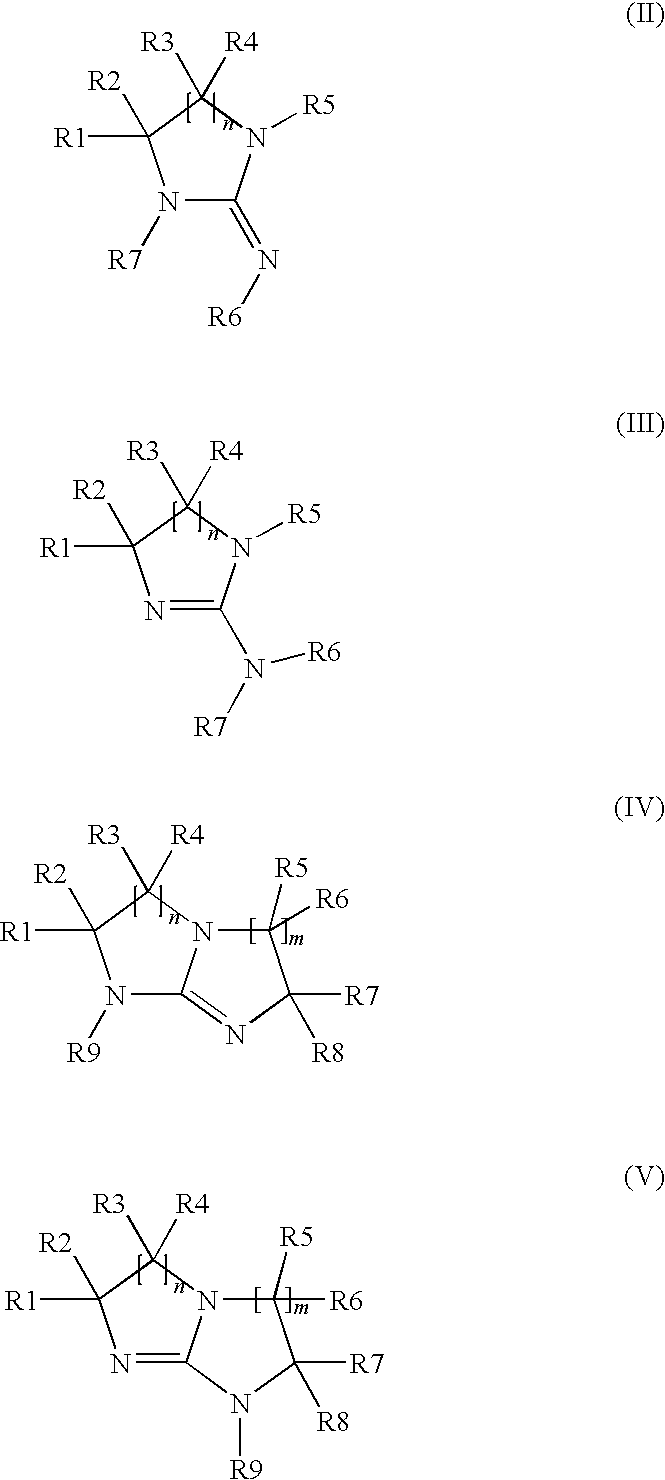Electrodepositable coating composition containing a cyclic guanidine
a technology of cyclic guanidine and coating composition, which is applied in the direction of fluid pressure measurement, liquid/fluent solid measurement, peptide, etc., can solve the problems of reducing the efficiency of bismuth, affecting the stability of cyclic guanidine coating composition,
- Summary
- Abstract
- Description
- Claims
- Application Information
AI Technical Summary
Benefits of technology
Problems solved by technology
Method used
Image
Examples
example 1
(a) An Undispersed Electrodepositable Resin
[0129]
AEPON 88011103.88Bisphenol A402.83Methyl isobutyl ketone168.60BEthyltriphenyl phosphonium iodide1.45CCrosslinker2961.62DDiethanol amine18.94EDiketimine397.64FButylcarbitol formal294.91Methyl isobutyl ketone92.34GEpoxy additive4790.101Epoxy resin available from Hexion Specialty Chemicals2Crosslinker prepared from the reaction of Hexamethylene triamine and propylene carbonate in 70% solids in MIBK3MIBK diketimine of diethylene triamine at 72.7% in MIBK4Epoxy additive was prepared by reacting EPON 880 with BPA to EEW of 935 and aminating with diethanol amine and ketimine.
[0130]Procedure: All weights are in grams. Items A and B are charged to a 4 neck round bottom flask, fit with a stirrer, temperature measuring probe, N2 blanket and heated to 130° C. The mixture exotherms. Begin 1 hour hold at 145° C. The peak exotherm was 146° C. and the temperature allowed to drop to 145° C. After 1 hour, the reaction was cooled to 110° C. and charge C...
example 2
(a) A Crosslinker
[0131]
#Materialgm1Isocyanate11876.002Dibutyltin dilaurate0.353Methyl isobutyl ketone (mibk)21.734Diethyleneglycol monobutyl ether454.245Ethyleneglycol monobutyl ether1323.626Methylisobutyl ketone mibk296.011Rubinate M, available from Huntsman Corporation
[0132]Procedure: All weights are in grams. Items 1, 2 and 3 are charged to a 4 neck round bottom flask, fit with a stirrer, temperature measuring probe and N2 blanket. Charge 4 was added slowly allowing the temperature to increase to 60° C. The mixture was then held at 60° C. for 30 minutes. Charge 5 was then added over about 2 hours allowing the temperature to increase to a maximum of 110° C. Charge 6 was then added and the mixture was held at 110° C. until the i.r. spectrum indicates no residual isocyanate.
example 3
(a) A Cationic Resin
[0133]
#MaterialGm1EPON 8281614.682Bisphenol A265.423MACOL 98 A MOD 12125.04Methylisobutyl ketone (mibk)31.095Ethyltriphenyl phosphonium iodide0.606MACOL 98 A MOD 12125.007Methylisobutyl ketone (mibk)52.058Example 2, crosslinker719.679Ketimine357.0110N-methyl ethanolamine48.6811sulfamic acid19.3612H2O573.8413H2O657.6514H2O550.01Epoxy resin available from Hexion Specialty Chemicals.2Bisphenol ethylene oxide adduct available from BASE Corporation.3MIBK diketimine of diethylene triamine at 72.7% in MIBK.
[0134]Procedure: All weights are in grams. Items 1, 2, 3, 4 and 5 are charged to a 4 neck round bottom flask, fit with a stirrer, temperature measuring probe, N2 blanket and heated to 130° C. The mixture exotherms to about 150° C. The temperature was allowed to drop to 145° C. and held at this temperature for 2 hours. Charges 6 and 7 were then added. Charges 8, 9 and 10 were added and the mixture was held at 122° C. for two hours. 877 g of the reaction mixture was pou...
PUM
| Property | Measurement | Unit |
|---|---|---|
| temperature | aaaaa | aaaaa |
| temperature | aaaaa | aaaaa |
| temperature | aaaaa | aaaaa |
Abstract
Description
Claims
Application Information
 Login to View More
Login to View More - R&D
- Intellectual Property
- Life Sciences
- Materials
- Tech Scout
- Unparalleled Data Quality
- Higher Quality Content
- 60% Fewer Hallucinations
Browse by: Latest US Patents, China's latest patents, Technical Efficacy Thesaurus, Application Domain, Technology Topic, Popular Technical Reports.
© 2025 PatSnap. All rights reserved.Legal|Privacy policy|Modern Slavery Act Transparency Statement|Sitemap|About US| Contact US: help@patsnap.com



